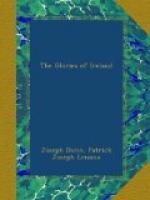After Commodore Perry, the victor in the battle of Lake Erie, and himself the son of an Irish mother, the northern naval glory of the War of 1812 falls to Lieutenant Thomas MacDonough, of Irish descent, whose victory on Lake Champlain over the British squadron was almost as important as Perry’s. Admiral Charles L. Stewart ("Old Ironsides"), who commanded the frigate Constitution when she captured the Cyane and the Levant, fighting them by moonlight, was a great and renowned figure. His parents came from Ireland, and Charles Stewart Parnell’s mother was the great sea-fighter’s daughter. Lieutenant Stephen Cassin commanded the Ticonderoga and fought her well. Captain Johnston Blakely, who was born in Ireland, captured in the Wasp of 18 guns the much larger British Reindeer of 20 guns and 175 men in a splendid fight, and later sank the Avon, an 18-gun brig. After capturing a great prize, which he sent to Savannah, he sailed for the Spanish main and was never heard of more. Captain Boyle, in the privateer Comet of Baltimore, fought the Hibernia, of 18 guns, and later in the Chasseur, known as the phantom ship, so fast she sailed, took eighty prizes on the high seas. General A.E. Maccomb, who commanded victoriously at Plattsburg, was of Irish descent, and Colonel Robert Carr, who distinguished himself in the same campaign, was born in Ireland. Major George Croghan of Kentucky, the hero of Fort Stephenson, was the son of an Irish father who had been a soldier in the Revolution. Colonel Hugh Brady, of the 22nd Infantry, commanded at Niagara. He remained in the army and fought in Mexico. William McRee, of Irish descent, was General Browne’s chief engineer in laying out the military works of the American army at Niagara.
Let it not be forgotten that in this memorable company brave Mrs. Doyle has a place. Her husband, Patrick Doyle, an Irish artilleryman, had been taken prisoner by the British in the affair at Queenston and had been refused a parole. Accordingly, when the guns were trained on the English lines before Fort Niagara, Mary, emulating the example of her countrywoman, “Molly” Pitcher, at Monmouth, determined to take her husband’s place, and, regardless of flying British balls, tended a blacksmith’s bellows all day, providing red-hot shot for the American gun battery, and sending a prayer with every shot into the British lines.




